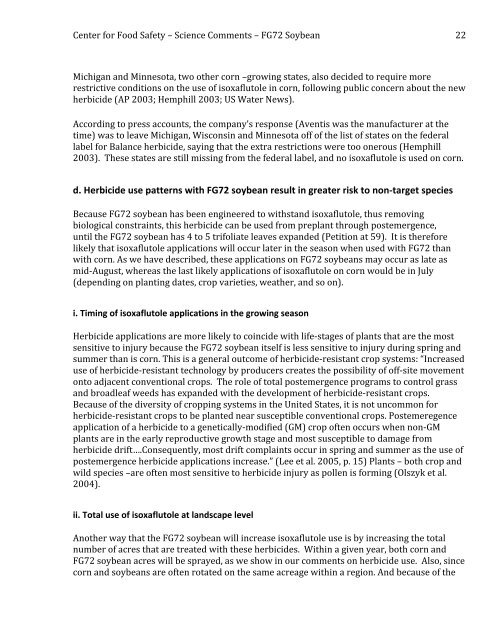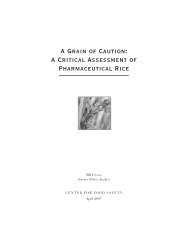a four-fold rise - Center for Food Safety
a four-fold rise - Center for Food Safety
a four-fold rise - Center for Food Safety
You also want an ePaper? Increase the reach of your titles
YUMPU automatically turns print PDFs into web optimized ePapers that Google loves.
<strong>Center</strong> <strong>for</strong> <strong>Food</strong> <strong>Safety</strong> – Science Comments – FG72 Soybean <br />
22 <br />
Michigan and Minnesota, two other corn –growing states, also decided to require more <br />
restrictive conditions on the use of isoxaflutole in corn, following public concern about the new <br />
herbicide (AP 2003; Hemphill 2003; US Water News). <br />
According to press accounts, the company’s response (Aventis was the manufacturer at the <br />
time) was to leave Michigan, Wisconsin and Minnesota off of the list of states on the federal <br />
label <strong>for</strong> Balance herbicide, saying that the extra restrictions were too onerous (Hemphill <br />
2003). These states are still missing from the federal label, and no isoxaflutole is used on corn. <br />
d. Herbicide use patterns with FG72 soybean result in greater risk to non-‐target species <br />
Because FG72 soybean has been engineered to withstand isoxaflutole, thus removing <br />
biological constraints, this herbicide can be used from preplant through postemergence, <br />
until the FG72 soybean has 4 to 5 trifoliate leaves expanded (Petition at 59). It is there<strong>for</strong>e <br />
likely that isoxaflutole applications will occur later in the season when used with FG72 than <br />
with corn. As we have described, these applications on FG72 soybeans may occur as late as <br />
mid-‐August, whereas the last likely applications of isoxaflutole on corn would be in July <br />
(depending on planting dates, crop varieties, weather, and so on). <br />
i. Timing of isoxaflutole applications in the growing season <br />
Herbicide applications are more likely to coincide with life-‐stages of plants that are the most <br />
sensitive to injury because the FG72 soybean itself is less sensitive to injury during spring and <br />
summer than is corn. This is a general outcome of herbicide-‐resistant crop systems: “Increased <br />
use of herbicide-‐resistant technology by producers creates the possibility of off-‐site movement <br />
onto adjacent conventional crops. The role of total postemergence programs to control grass <br />
and broadleaf weeds has expanded with the development of herbicide-‐resistant crops. <br />
Because of the diversity of cropping systems in the United States, it is not uncommon <strong>for</strong> <br />
herbicide-‐resistant crops to be planted near susceptible conventional crops. Postemeregence <br />
application of a herbicide to a genetically-‐modified (GM) crop often occurs when non-‐GM <br />
plants are in the early reproductive growth stage and most susceptible to damage from <br />
herbicide drift….Consequently, most drift complaints occur in spring and summer as the use of <br />
postemergence herbicide applications increase.” (Lee et al. 2005, p. 15) Plants – both crop and <br />
wild species –are often most sensitive to herbicide injury as pollen is <strong>for</strong>ming (Olszyk et al. <br />
2004). <br />
ii. Total use of isoxaflutole at landscape level <br />
Another way that the FG72 soybean will increase isoxaflutole use is by increasing the total <br />
number of acres that are treated with these herbicides. Within a given year, both corn and <br />
FG72 soybean acres will be sprayed, as we show in our comments on herbicide use. Also, since <br />
corn and soybeans are often rotated on the same acreage within a region. And because of the







